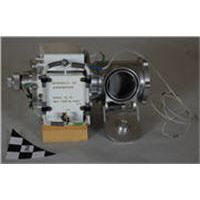Online Collections at UoB - Objects
ID number: BIRRC-P0886
Institution: Research and Cultural Collections
Named collection: Historic Physics Collection
Artist / Maker: Birmingham University Space Research Workshop
Title / Object name: Micrometeoroid detector
Object type: Physics apparatus
Place made: Europe: United Kingdom, West Midlands, Birmingham
Date made: 1969-71
Materials: Various metals and other materials
Measurements: 25 x 20 x 12 cm
|

|
The Birmingham micrometeoroid detector was flown on the Prospero satellite in 1971/72. Prospero was launched by a Black Arrow rocket, the first and last launch of a satellite by a British rocket.
At that time the micrometeoroid environment in near-Earth space was unknown, but extrapolation from the flux of more massive particles suggested that the micrometeoroid flux might be sufficiently great to present a significant hazard to spacecraft. (The flux at greater masses increases logarithmically with decreasing mass.)
The Birmingham instrument was sensitive to masses a factor of 1000 lower than previous detectors. Micrometeoroids were incident with velocities of 10-72 km s-1 onto a metal target, where they were impact ionised. The electron component of the microplasma so formed was drawn off and amplified by an electron multiplier. Each pulse thus generated was counted as a function of time, and the data was periodically transmitted to a station on the Falkland Islands. The instrument was designed by D.K.Bedford at Birmingham and developed and flown in collaboration with Marconi Ltd.
Inscriptions / Translations: UNIVERSITY OF BIRMINGHAM
SERIAL No. F3
UNIT CODE No. 4200/2/5
|
| << Viewing Record 781 of 1323 >> |